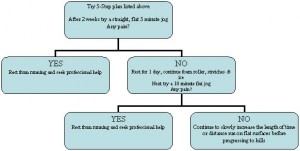
There are few things more frustrating than being injured when training for a big race. The race date seems to creep closer and closer and the chances of that personal best further and further away… Here is some self-help for one of those niggling problems faced by runners today.
Runner’s Knee: What are the symptoms?
Runner’s Knee is a common running injury known to those in the health trade as Ilio-Tibial Band Syndrome (ITBS). Ironically, despite its name, it is only the second most common knee injury amongst runners; the most common being mal-tracking of the kneecap. ITBS gives you a gradually worsening pain down the outside of your thigh towards your knee, often after about 20 minutes into a run. It will go away with rest, and come back the next time you run. It often does not hurt during everyday activities, and therefore leaves runners confused and exasperated as to why it is there and what can be done about it.
Some background anatomy…
The Ilio-Tibial Band (ITB) is a thick connective tissue that runs all the way down the outside of your thigh, linking your hip flexors and gluteal muscles at the pelvis to the bone below your knee. It is prone to getting irritated in the area just above the knee as it passes closely over the bone and other irritable structures like bursa (fluid-filled anti-friction pockets), nerves and tendons. It can often feel tight, but is difficult to stretch effectively, as it is not a muscle and therefore has fewer stretch receptors.
Common causes of Runners Knee:
As with most injuries, the problem could be caused by internal risk factors related to you, how you are built and how you move, or external risk factors related to how you train, or both.
Internal
- Weak or tight hip muscles
- Weak or tight hamstrings compared to quadriceps
- Poor balance
- Over-pronating feet
- Bony malalignment
- New to running / sudden increase in mileage
- Excessive downhill running
- Running on a camber i.e. always one side of the road
- Inappropriate running shoes
External
What to do if you have runners knee
The sooner you recognise the symptoms and do something about it, the quicker it will go away. The ones that take ages to get better are the ones who pushed on through for months and months before finally deciding to seek help. If race day is approaching, do not delay; get yourself in to see a good sports physiotherapist straight away. If you have the luxury of a bit of time to spare, try these easy steps to get it sorted:
- Try 2 weeks’ rest from running: Maintain your fitness up by doing upper body conditioning or swimming using arms only
- Ice for 10min as regularly as possible
Stretch your hip flexors, glutes and hamstrings
Use a foam roller to soften the ITB (warning: it’s not nice!) - Work on your balance standing on one leg, keeping your hips level both sides (if this is too easy, try it with your eyes shut)
When to seek professional help
If the injury does not settle down with the basic steps, seeking professional help is a good plan in case the diagnosis is incorrect. If it is ITBS, seeing a sports physiotherapist can help by assessing your movement, analysing which muscles are possibly over- and under-working or causing imbalances. They can design an individualised rehabilitation programme for you to correct the underlying problems. Soft tissue release by a sports physiotherapist and/or sports massage therapist to the tight muscles and along the length of the ITB can be extremely helpful.
A biomechanical and running analysis is also a good idea, ideally carried out by a qualified sports podiatrist or a biomechanical specialist. This can help determine whether your foot type is leading you to imbalances and injury.
When should surgery be considered?
Surgery for this type of problem should only be considered as a last resort after all other options have been trialed first, as the research shows mixed results.
In summary
Runner’s knee is a niggle that you shouldn’t just sit and suffer, get it sorted and get back on the road!




